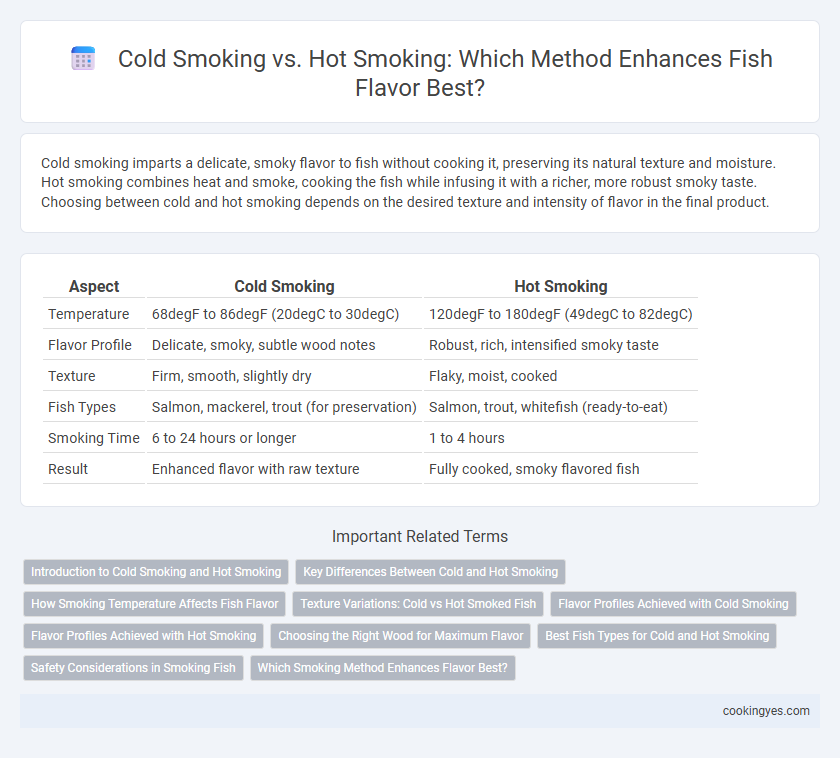Cold smoking imparts a delicate, smoky flavor to fish without cooking it, preserving its natural texture and moisture. Hot smoking combines heat and smoke, cooking the fish while infusing it with a richer, more robust smoky taste. Choosing between cold and hot smoking depends on the desired texture and intensity of flavor in the final product.
Table of Comparison
| Aspect | Cold Smoking | Hot Smoking |
|---|---|---|
| Temperature | 68degF to 86degF (20degC to 30degC) | 120degF to 180degF (49degC to 82degC) |
| Flavor Profile | Delicate, smoky, subtle wood notes | Robust, rich, intensified smoky taste |
| Texture | Firm, smooth, slightly dry | Flaky, moist, cooked |
| Fish Types | Salmon, mackerel, trout (for preservation) | Salmon, trout, whitefish (ready-to-eat) |
| Smoking Time | 6 to 24 hours or longer | 1 to 4 hours |
| Result | Enhanced flavor with raw texture | Fully cooked, smoky flavored fish |
Introduction to Cold Smoking and Hot Smoking
Cold smoking preserves fish by exposing it to low temperatures between 68-86degF (20-30degC), infusing delicate smoky flavors while maintaining a raw-like texture. Hot smoking cooks fish at higher temperatures, typically between 165-185degF (74-85degC), producing a flaky texture with rich, robust smoky aromas. Each method offers distinct flavor profiles, with cold smoking emphasizing subtlety and preservation, and hot smoking delivering a cooked, savory depth.
Key Differences Between Cold and Hot Smoking
Cold smoking imparts a delicate smoky flavor to fish by exposing it to smoke at temperatures below 90degF (32degC), preserving its raw texture while enhancing taste. Hot smoking cooks the fish at higher temperatures, typically between 120degF to 180degF (49degC to 82degC), resulting in a firmer texture and a robust, cooked smoky flavor. The key difference lies in temperature control and cooking method, with cold smoking focusing on flavor infusion without cooking, and hot smoking combining cooking and smoke flavor development.
How Smoking Temperature Affects Fish Flavor
Cold smoking preserves delicate fish flavors by infusing subtle smoky notes without cooking, maintaining a silky texture and nuanced taste profile. Hot smoking exposes fish to higher temperatures, cooking the flesh and creating bold, robust smoky flavors with a firmer, flakier texture. Temperature directly influences the balance of moisture retention, smoke penetration, and flavor intensity, making it critical for achieving the desired sensory experience in smoked fish.
Texture Variations: Cold vs Hot Smoked Fish
Cold smoking fish preserves a delicate, silky texture by curing it at temperatures below 90degF (32degC), allowing smoke to infuse flavor without cooking the flesh. Hot smoking cooks fish at temperatures between 120degF to 180degF (49degC to 82degC), producing a firmer, flaky texture with a deeper smoky profile. The choice between cold and hot smoking primarily affects the moisture content and tenderness, with cold smoking maintaining moisture for a supple bite and hot smoking resulting in a drier, more robust texture.
Flavor Profiles Achieved with Cold Smoking
Cold smoking fish imparts a delicate, subtle smoky aroma without cooking the flesh, preserving the natural moisture and texture for a silky, tender bite. This method enhances nuanced flavors, such as nuances of wood types like alder or hickory, creating complex, layered taste profiles prized in artisanal smoked salmon and trout. Cold smoking typically results in a refined, lightly smoky flavor that emphasizes the fish's inherent sweetness and freshness compared to the robust, cooked flavor produced by hot smoking.
Flavor Profiles Achieved with Hot Smoking
Hot smoking imparts a robust, smoky flavor to fish, enhancing natural oils and creating a firm, flaky texture through cooking during the smoking process. The higher temperatures, typically between 165degF and 185degF (74degC to 85degC), encourage Maillard reactions that deepen flavor complexity and produce a savory, caramelized crust. This method highlights bold, intense notes ideal for species like salmon and mackerel, where a pronounced smoky character complements the fish's inherent richness.
Choosing the Right Wood for Maximum Flavor
Cold smoking imparts a delicate, smoky aroma to fish without cooking it, favoring woods like alder or apple for their mild, sweet flavors that enhance natural fish tastes. Hot smoking cooks the fish and infuses stronger smoke profiles, with hickory or mesquite woods delivering bold, robust flavors ideal for hearty fish varieties. Selecting the right wood depends on the desired flavor intensity and fish type, balancing smoke temperature and wood characteristics for optimal taste.
Best Fish Types for Cold and Hot Smoking
Cold smoking imparts a delicate, smoky flavor ideal for fatty fish like salmon, trout, and mackerel, which absorb the low heat smoke over extended periods, enhancing their natural oils without cooking the flesh. Hot smoking cooks the fish while infusing a robust smoky taste, best suited for firm, lean fish such as cod, haddock, and bluefish, which hold up well to higher temperatures and develop a flaky texture. Choosing the right smoking method depends on the fish's fat content and texture to achieve optimal flavor and mouthfeel.
Safety Considerations in Smoking Fish
Cold smoking fish occurs at temperatures below 90degF (32degC), which requires careful control to prevent bacterial growth, especially Listeria monocytogenes, posing a significant safety risk if not properly handled. Hot smoking heats fish to internal temperatures of 145degF (63degC) or higher, effectively killing pathogens and ensuring safer consumption by simultaneously cooking the fish. Temperature control and proper curing processes are critical in both methods to minimize the risk of foodborne illnesses while enhancing flavor.
Which Smoking Method Enhances Flavor Best?
Cold smoking fish imparts a delicate, smoky aroma by slowly exposing it to smoke at temperatures below 90degF (32degC), preserving the fish's natural texture and enhancing subtle flavors. Hot smoking cooks the fish at higher temperatures (typically 120-180degF or 49-82degC), resulting in a firmer texture with a robust, intensified smoky taste that penetrates deeper. For maximizing flavor, hot smoking often produces a more pronounced and savory profile, while cold smoking offers a milder, nuanced flavor best suited for tender, raw preparations.
Cold smoking vs Hot smoking for flavor Infographic

 cookingyes.com
cookingyes.com